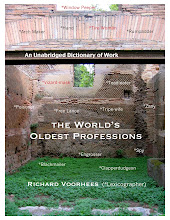A literate, dexterous, dogged writer and copyist.
"The scribe to whom a poor-quality parchment had been given was in for a very disagreeable task, and in the margins of surviving monastic manuscripts there are occasional outbursts of distress: 'The parchment is hairy' . . . 'Thin ink, bad parchment, difficult text' . . . 'Thank God, it will soon be dark.' 'Let the copyist be permitted to put an end to his labor,' a weary monk wrote beneath his name, the date, and the place where he worked; 'Now I've written the whole thing," wrote another. 'For Christ's sake give me a drink.'"
The Swerve, How the World Became Modern, Stephen Greenblatt (2011).
Friday, January 31, 2014
Friday, January 17, 2014
Cryptanalyst
A codebreaker.
"The philosopher of the Arabs," al-Kindi, wrote a treatise entitled A Manuscript on Deciphering Cryptographic Messages in the 9th century A.D.
As a "wartime mathematical cryptanalyst put it, the creative codebreaker must 'perforce commune daily with dark spirits to accomplish his feats of mental ju-jitsu.'"
Simon Singh, The Code Book (1999).
"The philosopher of the Arabs," al-Kindi, wrote a treatise entitled A Manuscript on Deciphering Cryptographic Messages in the 9th century A.D.
As a "wartime mathematical cryptanalyst put it, the creative codebreaker must 'perforce commune daily with dark spirits to accomplish his feats of mental ju-jitsu.'"
Simon Singh, The Code Book (1999).
Thursday, January 16, 2014
Cryptographers
Cryptographers specialize in the extremely ancient art of writing coded messages.
In the 5th century B.C., Herodotus recounted an "incident in which concealment was sufficient to secure the safe passage of a message. He chronicled the story of Histaiaeus, who wanted to encourage Aristagoras of Miletus to revolt against the Persian king [Xerxes]. To convey his instructions securely, Histaiaeus shaved the head of his messenger, wrote the message on his scalp, and then waited for the hair to regrow. This was clearly a period of history that tolerated a certain lack of urgency. The messenger, apparently carrying nothing contentious, could travel without being harassed. Upon arriving at his destination he then shaved his head and pointed it at the intended recipient."
Simon Singh, The Code Book (1999).
In the 5th century B.C., Herodotus recounted an "incident in which concealment was sufficient to secure the safe passage of a message. He chronicled the story of Histaiaeus, who wanted to encourage Aristagoras of Miletus to revolt against the Persian king [Xerxes]. To convey his instructions securely, Histaiaeus shaved the head of his messenger, wrote the message on his scalp, and then waited for the hair to regrow. This was clearly a period of history that tolerated a certain lack of urgency. The messenger, apparently carrying nothing contentious, could travel without being harassed. Upon arriving at his destination he then shaved his head and pointed it at the intended recipient."
Simon Singh, The Code Book (1999).
Subscribe to:
Posts (Atom)
